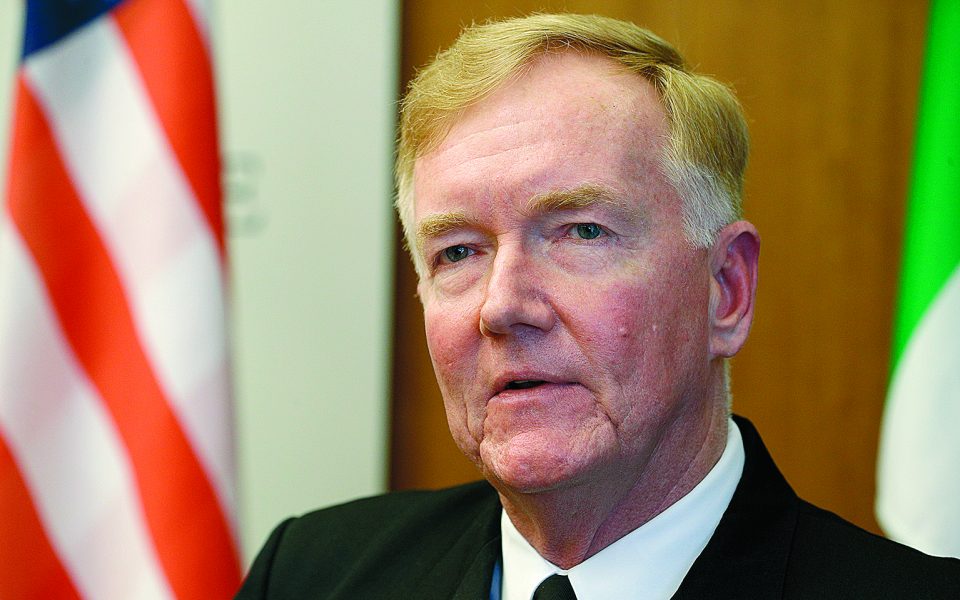No surprise Turkey is paying the price for the S-400s

The decision to suspend Turkey’s participation in the F-35 program in response to its purchase of the Russian S-400 missile defense system came as no surprise, but the United States and the West must continue trying to resolve political differences through dialogue, James Foggo, a retired United States Navy admiral with 39 years of service and a Distinguished Fellow with the Transatlantic Defense and Security Program at the Center for European Policy Analysis (CEPA), tells Kathimerini.
The last post Foggo held from 2017 to 2020 before retiring was commander of the Allied Joint Force Command in Naples and he firmly believes that the Mediterranean is at the epicenter of geopolitical developments.
Foggo, who is due to speak at the Delphi Economic Forum on May 10-14, also provides an analysis of the maritime domain in the 21st century, saying that within the next few decades, a quarter of the American naval force will consist of unmanned platforms.
When we last met you were commander of JFC Naples and the United States Naval Forces Europe-Africa (NAVEUR-NAVAF). Do you believe that we are witnessing a shift in global trends that is pushing the Mediterranean back into the geopolitical center of gravity?
I have always believed, since the early days of my commissioned service in the United States Navy, that the Mediterranean is an “artery” which carries the life blood of commerce and trade from North America to Europe via the Mediterranean and through the Bosporus into the Black Sea or transiting the Suez Canal into the Red Sea and ultimately into the Arabian Gulf or the Indian Ocean. The global focus on the Mediterranean has endured throughout human history and is important now more than ever because of great power competition. In the 21st century, this competition in the maritime domain underscores the importance of the sea lines of communication (SLOCs) and “access” which we enjoy thanks to traditional allies and partners. The nation of Greece is one of those traditional allies and friends of the United States and it is located in one of the most active maritime regions of the world – the Mediterranean – where Greek mariners have sailed since the time of Homer’s Odyssey.
We in the East Mediterranean have witnessed huge turmoil in the past few years. One of its most visible characteristics is Turkey’s numerous operations in its periphery – Turkish troops in Syria and Iraq, military presence and aid with the promotion of foreign fighters in Libya and the South Caucasus (Nagorno-Karabakh) – but also a very close alignment with actors like Russia. The S-400s are the main issue there. Why is Turkey adopting this stance? Do you believe that Turkey is increasingly distancing itself from the West?
While I served at Supreme Headquarters Allied Powers Europe (SHAPE HQ) in 2009, the Supreme Allied Commander Admiral Jim Stavridis – a great Greek-American naval officer – adopted a simple mantra for Allied Command Operations: “We are stronger together!” I firmly believed, as he did, in the power of these four words. Turkey has been a member of NATO since 1951. Turkish soldiers, sailors and airmen served alongside 29 other NATO national contingents at Allied Joint Force Command Headquarters in Naples, Italy during my time as the commander. Always cordial and professional, Turkish military personnel contributed to the success of our missions across a broad range of Alliance operations despite obvious political tensions with Ankara over a number of policy issues that you have articulated in your question. Although I was surprised at Turkey’s decision to procure the Russian S-400 air defense system, I was not surprised by the US and Allied response to suspend Turkey’s participation in the F-35 consortium. As intended, I believe that this decision will negatively impact Turkey in terms of technological development, economic benefit and interoperability with other NATO allies – a high price to pay for adoption of the S-400. Despite these actions, Turkey remains a member of the NATO Alliance and still maintains its goals of Euro-Atlantic integration. Impediments to progress remain at the political level and this is where the diplomats play an important role. The United States has two of our most experienced interlocutors at the diplomatic level working these issues on a day-to-day basis – Ambassador Geoff Pyatt (Greece) and Ambassador David Satterfield (Turkey). I know them both and I share high confidence in their abilities to help us resolve differences and seek compromise at the political level.
I believe that diplomatic resolution of political differences with our Turkish allies depends on continued dialogue. One of the best examples of cooperation with the professional military of Turkey exists right in the heart of the Mediterranean at the NATO Maritime Interdiction and Operations Training Center (NMIOTC) at Souda Bay (Crete).
And so you see, in the final analysis, it is much better for Turkey to remain a member of NATO than to be an outsider. The frank dialogue and cooperation between NATO members and our Turkish allies must continue beyond NMIOTC into the forum of the North Atlantic Council (NAC) and the NATO Military Committee. I look forward to smoother sailing amongst the allies during the remainder of 2021 and beyond.
There is an ongoing public (but not only) discussion in the US on the future of the US Navy. Even though the sizes are far from comparable, a similar discourse is taking place about the Hellenic Navy on the occasion of a tender for new frigates. Right now we are talking about unmanned vessels (surface and underwater), combined capabilities etc. In your view, where does a modern navy have to turn to remain effective and relevant?
You likely noticed that the aircraft carrier USS Dwight D. Eisenhower appeared in Greek waters and my successor, Admiral Robert Burke, hosted Prime Minister Kyriakos Mitsokakis and other Greek leaders on board in Souda Bay. To the American people, the US aircraft carrier represents 90,000 tons of diplomacy. When it deploys, it carries 5 acres of sovereign US territory that can sail quickly to anyplace in the world and operate close to 70 strike fighter, surveillance, refueling or rotary wing aircraft. Nearly 5,500 US Navy sailors make these ships run like a Swiss watch for up to seven to nine months at a time. The cost to build a new aircraft carrier like the USS Gerald R. Ford is about $13.5 billion. The US currently has 12 aircraft carriers that must be manned, trained and equipped above and beyond the startup costs. These costs are clearly a matter of past and current debate in Washington.
I often quote one of my favorite authors, Robert Kaplan, who stated that this is not just the maritime decade, but rather the maritime century. Unmanned systems are not a wholesale substitute for manned platforms, but they are “enablers” for manned platforms. The United States has produced unmanned surface, subsurface and aerial platforms that could be disruptive in the manner in which we deploy maritime forces in the future. Currently, these unmanned platforms perform missions such as intelligence, surveillance and reconnaissance (ISR); strike; logistics resupply; and refueling – just to name a few. Much to consider – the possibilities are endless.
On the subject of the Greek frigate, I’m all for anything that serves as a force multiplier for NATO navies, and the sooner the better. Generally speaking, frigates are the multi-mission platforms designed to operate in blue water or the littoral, in accompaniment of a larger strike group or surface action group, or even independently. While I was the Sixth Fleet Commander in Naples, the United States Navy decided to decommission all of the Oliver Hazard Perry-class frigates due to age. The last one that sailed through the Mediterranean at the time was USS Simpson (FFG 56) – a marvelous ship and crew. We had no plan for a follow-on frigate at the time and therefore employed the Joint High Speed Vessel (JHSV) as an “Expeditionary Patrol Frigate (EPF).” The EPFs, like USNS Trenton, no stranger to the port of Souda Bay, Crete, have been gainfully employed in the interim.
Our navy needs a new frigate and we have settled on the FREMM design to be built in the United States by Fincantieri Marinette Marine Shipyard in Wisconsin. These are marvelous ships. Just under 8,000 tons and slightly less than 500 feet, the Constellation-class frigate will be well armed and propelled by powerful LM2500 gas turbines. As the father of the American Navy, Captain John Paul Jones, once said, “Give me a fast ship for I intend to go in harm’s way!” That will be USS Constellation and her sister ship’s mantra as the American frigates come online to join Greece and other NATO navies in the defense of our mutual security interests in the maritime domain. In doing so, it will be even more important to maintain interoperability with our allies and partners.
Finally, as a submariner, and a former NATO commander of Allied Submarines South on Nisida, Italy, I am a huge proponent of both manned and unmanned systems in the undersea domain.
In the final analysis, I am proud of the fact that the Hellenic Navy operates modern Type 209 and 214-class hybrid diesel-electric submarines to contribute to collective defense and security in the undersea domain of the Mediterranean. These are magnificent boats commanded by world-class Greek officers and sailors.





